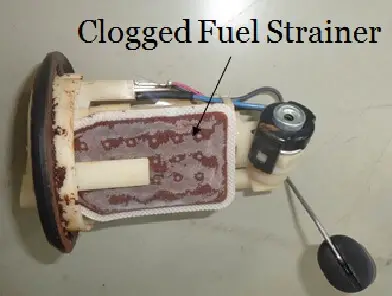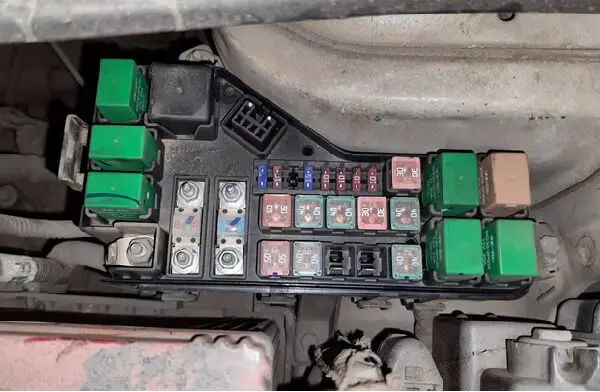Often you might have heard people complain that their vehicle suddenly stopped while they are on a trip to enjoy holidays or while driving on their way to the workplace or things like that.
The fuel pump fuse and relay are the most common items that grab attention to troubleshoot the problem with the less or no fuel delivery from the fuel pump.
Many times it is the fuel pump fuse that gets blown up. When you try to fix the fuel pump fuse by replacing it with a new one, it seems to work fine for a moment.
Then the new fuse also pops out after some time. These are the moments people often get annoyed and want to get rid of the problem at the earliest possible.
The issue of fuel pump fuse keeps blowing can be due to wiring short to ground, bad fuel pump, use of higher fuel pump fuse rating, incompatible fuel pump, shorted fuel pump relay circuit, blocked fuel line or fuel filter, faulty inertia switch, add-on load to fuel pump wiring and even residual heat and loose wiring connections can cause frequent fuel pump fuse blowing issues.
If the fuel pump keeps blowing in your vehicle and you are in search of a solution to solve the problem, then you are at the right place!
Here in this article, we will discuss causes for the fuel pump fuse getting blown and fixes to solve it!
Table Of Contents
What Are Fuel Pump Fuse And Relay?
The fuel pump fuse is a safety device that protects the electrical circuits and the fuel pump in the vehicle by breaking the circuit continuity in the event of an electrical overload condition in that circuit. The fuel pump fuse does this by blowing itself preferentially over the fuel pump.
Thus it helps in preventing overheating of wires and potentially dangerous fire risk from happening and hence plays a vital role in safeguarding the electrical devices and wirings on the vehicle.
The fuel pump fuse gets the power supply from the battery on one side and is connected to the loads or fuel pump on the other side via. fuel pump relay and inertia switch (if available).
The fuel pump fuse is a one-time use part. When it experiences heavy current flow across it, the metal wire in the fuse gets melted and results in non-continuous hence an open electrical circuit.
The fuel pump fuse is usually located under the dash. It can be easily accessed once you bend down beneath the vehicle glove box. In some vehicles it is located under the bonnet of the vehicle inside the TIPM (Total integrated power module), sometimes called the power distribution center of the vehicle, alongside all other vehicle relays.
Usually, a telltale label use to be available right beneath the steering of the vehicle to locate the required fuse with its ampere rating.
The fuel pump relay on the other hand is a device that makes or breaks circuit continuity or power supply to the fuel pump like an electrical switch. Relays are activated or deactivated by the vehicle ECM (Electronic control module), generally called a vehicle computer.
Unlike fuel pump fuse, the fuel pump relay can be operated several times during the life of the vehicle but the number of operations will be restricted only by the mechanical wear of the contacts and the electrical coil durability.
Fuel Pump Fuse Keeps Blowing? 9 Causes And Solutions To Fix It!
If your fuel pump fuse keeps on blowing even after replacing it with a fresh one. Then you would be wondering what causes fuel pump fuses to keep blowing?
So here we are going to discuss the most probable root cause for fuel pump fuse getting blown frequently. Which one applies to your vehicle needs to be identified and carefully analyzed to arrive at the fix. Here we go!
Wiring short to ground
When you turn the ignition on and you observe no power to the fuel pump, most likely there could be wiring short to the ground that would keep the fuel pump fuse blowing and cut off the power supply to the fuel pump.
Thoroughly inspect all the concerned wiring that goes from the fuel pump fuse at the front end extending up to the fuel pump at the vehicle rear end, via. the fuel pump relay.
Since the fuel pump fuse also supplies power to the fuel injectors, idle air control valve (IACV), and other parts, you may need to check the wiring and electrical load exerted by these parts as well.
Fuel pump end connectors and wiring is usually accessible through the access window or cut out provided on the vehicle underbody floor beneath the rear passenger seat.
The wiring harness while passing along the vehicle length may foul with many parts of the vehicle body and other sharp objects and in that process could get exposed at certain vulnerable locations.
After years and years of usage, the wiring may get damaged and get exposed due to wear and tear caused by vehicle vibration. Or it is also possible that the wiring is squeezed in between other parts and the inner conductive wire has got uncovered.
This would cause grounding of the wire to the metal part of the vehicle body and allows heavy current to pass through the wire. Hence you would notice that the fuel pump fuse keeps blowing every time you change it unless the grounded wire is not fixed.
Fix
It is recommended not to cover up the exposed wiring with electrical tape to fix this kind of problem, otherwise, it could recur again. Instead, cut the bad section out and splice in a butt connector and use a corrugated tube to protect the wiring and to keep it away from metal surfaces.
If the wiring short is near the fuel tank, it can cause a good amount of spark before the fuse could blow. Any sparking near the fuel tank where fuel vapors may be available would be a possible fire hazard hence needs immediate attention to fix it.
Many times, simply wiggling the wiring harness at congested locations through which the fuel pump fuse wires pass through, helps in keeping the fuel pump fuse from blowing away. Since it would prevent the contact of the wiring to any metal objects in vehicle.
Sometimes you may see spark/arc while wiggling and that may assist you in identifying the location of the short/ground in wiring. This may sound crazy but it works often!
Doing the re-wiring of the fuel pump harness with hot wires to be considered as the last option if nothing else works and the wiring has undergone tremendous wear and tear.
Hard or bad fuel pump

The fuel pump is the continuously operating part of the vehicle. But over some period of running the fuel pump performance would start deteriorating. This could be due to a clogged-up pump strainer or damaged and choked-up impeller of the fuel pump or any other internal pump parts.
The failing fuel pump would need to do more work for delivering the required pressure and output, hence would start drawing more current (say 25 Amp) which would normally draw less current (say 2 A to 10A) depending upon the pump wattage, delivery pressure, and flow rate.
If you notice that the fuel pump is drawing more current than the factory recommendation, then there is something seriously wrong with the fuel pump.
The oxidized or contaminated fuel contributes to the above problems and blocks the pump strainer. So the pressure drop across the strainer would call for more work to be done by the pump to compensate for it.
More current drawn would result in more heat loss which is directly proportional to the current (I2rt loss), so the heat generated will be sufficient enough to blow the fuel pump fuse.
The fuel pump draws more current than the fuel pump fuse can handle and in that case, you would experience that the fuel pump fuse keeps blowing even after fixing one unless the fuel pump is replaced with a new one.
More often the early clogging of the fuel pump strainer and the pump performance degradation happens when you have the habit of running the vehicle with a very low fuel level.
This would allow the dust matters which usually get settled at the tank bottom to get entangled into the strainer or inside the fuel pump. You may try replacing the fuel strainer and see if the problem gets fixed!
The fuel pump also doesn’t get cooled due to low fuel level and gets deteriorated. Thus the fuel pump ends up drawing more current to work against the dirt matters, so would sometime notice that the fuel pump fuse blows while driving.
Incorrect fuel pump fuse ampere rating
Are you using less amp rated fuse for the fuel pump than the factory recommended one? If yes, then this would ensure that the fuel pump fuse keeps blowing after some period of vehicle running until the recommended fuel pump fuse is replaced on the vehicle.
As a temporary fix, you may try using the fuel pump fuse with one size larger ampere rating to confirm whether the fuel pump fuse is blowing repeatedly due to an overloaded fuel pump or a failing fuel pump.
But confirm whether it is as per the recommendation given in the owner’s manual. Otherwise, the use of a much higher amp rating could blow out the fuel pump, injectors instead of the fuel pump fuse that would cause risk of fire in the wiring and may turn into nightmares.
Incompatible fuel pump
Frequently people end up using the wrong fuel pump for the vehicle. This means that higher wattage fuel pump is used in applications where a lower one is recommended or suitable for the given application.
The fuel pump having more muscles would draw more current for its running and this would keep the fuel pump fuse blowing unless it is replaced with the correct fuel pump with a factory recommended specifications.
This is because the fuel pump fuse is usually designed for sustaining amp. rating slightly above the current that the fuel pump would withdraw considering some factor of safety and pump aging over its life.
Shorted fuel pump relay circuit
A fuel pump relay is a device that has a coil winding inside on the control side of the electrical circuit and has switch contacts on the load side to the fuel pump.
The control side is connected to the input voltage and is grounded by the vehicle ECM. If there is a short in the wiring which is connecting the fuel pump relay to the ECM, then it could draw a large current across it.
This could keep on blowing the fuel pump fuse unless you fix the short in the fuel pump relay wiring. Measure the resistance between the fuel pump relay and the ECM, if the multimeter reads ‘0’ Ohms, then it confirms that there is a short to ground between the two.
If the fuel pump relay is misbehaving, then you try swapping the other relays in the vehicle TIPM box. Usually, the fuel pump relays rating matches with that of other relays in the TIPM box or you may keep fuel pump relay bypass cable handy and jump the defective fuel pump relay and stay on the road.
Blocked fuel line or fuel filter
It is worthwhile to thoroughly inspect the fuel lines for any pinching or kinking, starting from the fuel pump to the injector point, and also confirm that there is no blockage or clogging in the inline fuel filter.
These things would make the fuel pump struggle to run and deliver the fuel with the given restrictions in the supply line and would start to draw more current. So here you have all the reasons for the fuel pump fuse to keep blowing.
Many times the fuel line collapse go unnoticed and we work around other parts, since we assume there should not be a problem in the fuel line.
Slight fuel hose pinching would put backpressure on the fuel pump and could make it work hard enough to flow off the fuse, so it is wise to replace the fuel hoses that are damaged or collapsed.
If you remember that the fuel filter is recently changed during the recent servicing then also it is wise to reconfirm once again because we don’t know when the chunk of foreign matter would start accumulating inside the fuel filter since it depends on the fuel quality where we have no control. So replace the fuel filter, if it seems to be clogged-up.
Faulty inertia switch
The inertia switch is provided in most of the vehicles as a safety feature in the fuel pump electrical circuit between the fuel pump and the fuel pump relay.
The function of the inertia switch is to cut off the power supply to the fuel pump when the vehicle suffers an accident by sensing the vehicle’s inertia.
If the inertia switch is faulty or is suddenly shorted internally, then also it would draw a large current across it, causing the fuel pump fuse to blow while driving, until the bad inertia switch is replaced or fixed.
Disconnect the inertia switch and check whether the current load drops in the circuit to prevent the popping of the fuse.
Add-on load to fuel pump wiring
Many people have the habit of putting an additional load in the electrical circuit, which may be loudspeakers, LED lights, etc.
Have you connected any additional load on the fuel pump wiring circuit? If so, then it would also be drawing more current through the fuel pump fuse and you would experience that the fuel pump fuse blows while driving due to the add-on device.
If you have recently added one, then disconnect it and check whether the fuel pump fuse is ok to go!
Residual heat and loose wiring connections
If the fuel pump fuse blows frequently while driving only in hot weather, then it is possible that the heat buildup, improper or dodgy loose wiring connections especially in old wiring can lead to the fuel pump fuse failure.
Check and confirm that the fuel pump wiring and the connections are neat, clean, free of corrosion and it is fully pushed to the dead end.
How To Check Short In The Wiring?
A quick check would be to disconnect the fuel pump and replace the fuse with a new one and then turn the ignition on. If the fuel pump fuse still blows without any fuel pump load, then it’s a short in the wiring somewhere.
If the fuse doesn’t blow, then turn the ignition off and connect the fuel pump connector. Now turn on the ignition to check whether the fuel pump blows now. If it does, then the fuel pump is the faulty item that is drawing more current and makes the fuel pump blow off frequently.
But if you want to confirm the area where the short is, then you would need to do some testing iterations using a multimeter to arrive at the short locations.
First, disconnect the battery and pull off the connectors going to the ECM and the inertia switch from the fuel pump relay. Set the multimeter to read the resistance and set it to 200 Ohms or lower.
Peg one of the probe to the ground (any engine or chassis part) and the other probe in the fuel pump relay socket slot that gets connected to the inertia switch.
If the multimeter reads ‘0’ ohms or something close to it, then you have a short to ground in the electrical circuit between the fuel pump relay and the inertia switch.
If the meter reads high ohms, then plug the ECM connectors and test again. If it shows ‘0’ ohms, then there is a short in the wiring that goes to ECM.
Conclusion
Four out of five times, it is the wiring short that ensures the fuel pump relay keeps blowing, and next comes the bad or failing fuel pump that could draw more than desired electric current to blow the fuel pump fuse repeatedly.
Fix the short in the wire and get your car rock and rolling again! If not, then look for the other symptoms discussed so far, to identify the root cause of the fuse getting blown.
Hope the points covered could help in pinpointing the pain area in your vehicle and support in fixing the problem and would save few bucks and most importantly the time required to travel to & fro to the nearest service station.
Nothing is more exciting than troubleshooting and fixing your machine on your own! Isn’t it?
Happy Motoring!
References
https://www.k100-forum.com/t16437-fuel-pump-fuse-keeps-blowing
https://www.pistonheads.com/gassing/topic.asp?t=1357941
http://clubsmartcar.com/index.php?/topic/30737-help-fuel-pump-fuse-keeps-blowing/
Related Articles
Silverado Fuel Pump Control Module Bypass? Everything You Need To Know!
Fuel Pump Not Priming? Reasons And Solutions To Fix It!
Car Won’t Start After Fuel Pump Replacement? All You Need To Know!
Fuel Pump Primes But No Pressure? Everything you Need To Know!
Fuel Pump Runs Continuously With Key On? (9 Causes And Solutions To Fix It!)
Why Holley Fuel Pump Is So Loud And Noisy? 14 Causes And Solutions To Fix It!

